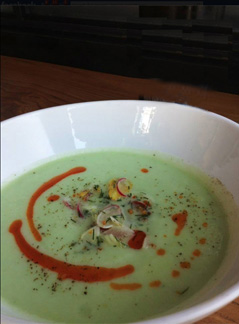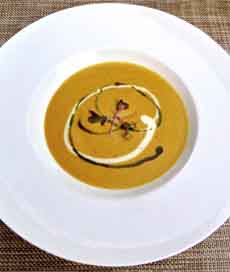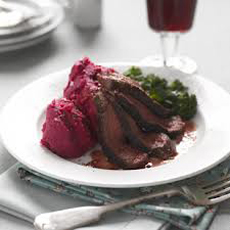|
Have you ever been served a bowl of soup with a drizzle of oil? Floating on the surface of the soup, it’s a fashionable garnish at better restaurants.
But the oil does more than look pretty. It adds a rich dimension of flavor to the soup and creates a more complex aroma. It’s an easy and inexpensive way to go from everyday to gourmet.
OIL DRIZZLE FOR SOUPS
In our book, a drizzle of flavored olive oil elevates a bowl of soup to top tier restaurant level. A tablespoon or less—depending on the size of the bowl—does the trick.
Depending on the soup, you can match an olive oil infused with basil, chile, garlic, oregano, rosemary, sage, smoked, truffle or wasabi, among others. You can use plain olive oil, of course; but we far prefer the exciting hit of flavor from infused oils.
You can also “go nuts” with almond, hazelnut, pecan, pistachio, walnut and other nut oils.
Other oils you may have in your pantry, from pumpkin seed to sesame, are also delicious accents.
|
|

Cucumber yogurt soup with a kick of chili oil, a garnish of thin-sliced baby radishes, fennel and diced orange. Photo courtesy The Chocolate Lab | San Francisco .
|
SOME SPECIFIC MATCHES
Avocado oil, lightly nutty and deep green, is delicious with black bean soup.
Basil oil, a lighter green, is wonderful with tomato soup (and any soup that could use a hit of basil).
Pumpkin seed oil, nutty with a dramatic deep green color, with gazpacho, tomato soup, roasted red pepper soup, lentil soup, split pea soup.
Rosemary oil is delicious with any bean or lamb-based soup.
Truffle Oil with to any soup, but we love it with chicken, beef and root vegetable soups like carrot and turnip. (Use less truffle oil than other oils, as it tends to have strong flavor.)
Sesame oil wherever you’d like an Asian accent (as with truffle oil, use less—droplets are the best option).
Walnut oil adds a toasty accent to puréed vegetable soups.
|

The double drizzle: pumpkin seed oil and
crème fraîche garnish squash soup. A few
microgreens garnish the center. Photo
courtesy The Grill Room | D.C. |
|
THE DOUBLE DRIZZLE
In a lighter soup you can contrast colored oils: a swirl of one with some contrasting droplets of another.
With a darker soup, you can use a cream-based product—crème fraîche, infused heavy cream, sour cream, yogurt.
HOW TO DRIZZLE
You may have natural technique, or you may have to practice to get a nice swirl. Place the oil on a teaspoon and drizzle from the tip. If you want to practice, drizzle inexpensive oil on a plate.
Another technique is to use a squeeze bottle or medicine dropper to create a circle of droplets, or a random pattern. In the top photo above, both swirls and droplets are used.
You can combine both techniques and use a different oil, or balsamic vinegar, for the droplets.
|
HOW TO DRIZZLE CREAMY GARNISHES
Heavy cream works just fine, but crème fraîche, sour cream and yogurt are too thick to drizzle; they need to be thinned. You can do this with water, milk or cream.
While sour cream and yogurt contribute natural tang, you can add flavor to them, or to crème fraîche or heavy cream. Lemon zest, flavored salt and pepper are some options. You can infuse heavy cream with herbs: crush the herbs and let them sit in the cream for an hour or longer. Strain and discard the herbs.
RECIPE: LEMON CRÈME FRAÎCHE
Ingredients
1/2 cup crème fraîche
1 teaspoon grated lemon zest
1 tablespoon of lemon juice
1 to 2 tablespoons water
1-2 dashes salt and pepper (to taste)
Preparation
1. BLEND the crème fraîche, lemon zest, lemon juice and salt and pepper.
2. THIN as needed with water to a drizzle consistency.
Soup’s on! And today, February 4th, is National Homemade Soup Day. Check out our favorite soup recipes.
|
|







